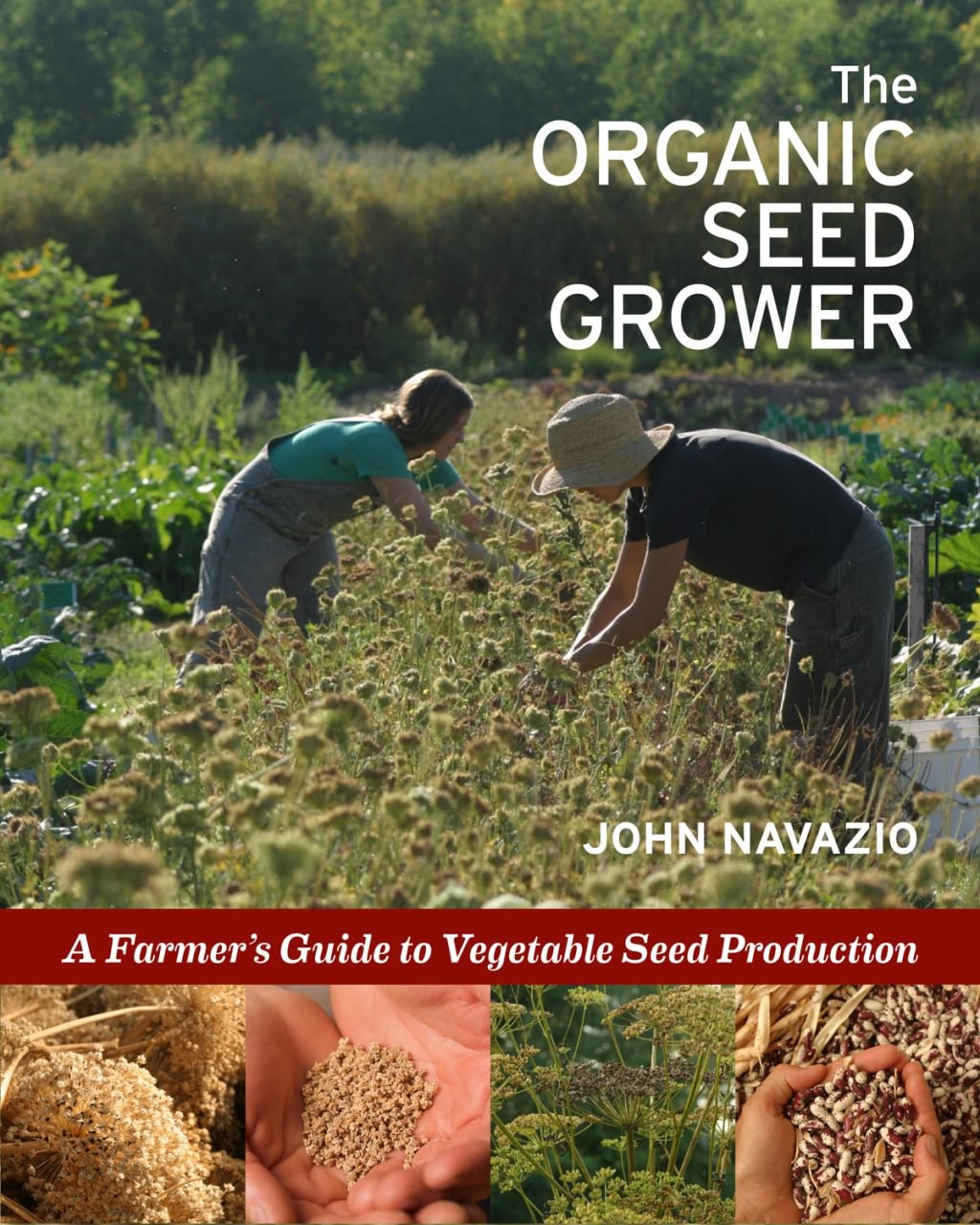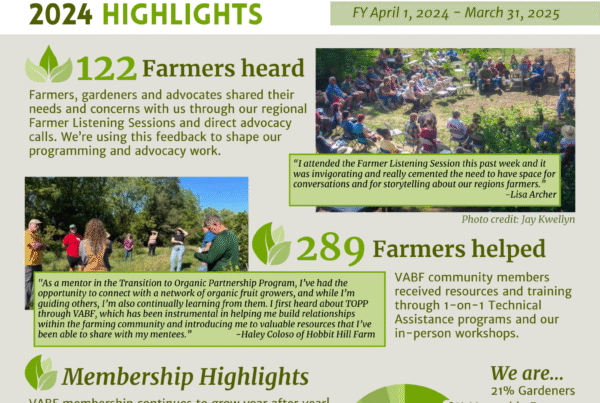by John Navazio
The slower growing season has arrived, and we start to think about next year. Perhaps you are considering growing some seed crops, either for your own use, or for extra income.
We’ve had Suzanne Ashworth’s Seed to Seed and Carol Deppe’s Breed your Own Vegetable Varieties, as well as Jeff McCormack’s valuable work at www.savingourseeds.org. John Navazio has given us his magnum opus, with the purpose of providing organic farmers the information to grow, select and produce seed of varieties suitable for organic production in their region. Little of this information has been available and patented hybrids suitable for large-scale non-organic production in ideal climates are increasingly most of what’s available. Those seeds are prima donnas requiring lots of external inputs (pesticides) and they come from giant corporations. As John puts it “After many organic farmers have been in the trenches for 15 or 20 years they increasingly developed sophisticated, sound farming practices” building soil fertility, structure and health through on-farm nutrient cycling and reducing machinery passes in their fields, they realized that many newer crop varieties didn’t fulfill their needs. Here’s a tool for growing better seed for ourselves.
The book includes a short historical and botanical info section of 27 pages (from which I learned more botany), and a 36 page Seed Grower Fundamentals section sandwiching the 300 page chunk on seed growing, crop family by crop family. There are also excellent references, glossary and index. In each of the crop family chapters there are easy-to-find sidebars giving basic parameters of seed production for that crop – the reference info a grower is most likely to need to check, once a decision on what to grow has been made. Quibble – why no mention of using hoophouses/high tunnels for seed growing?
The crop chapters include isolation distance, selection for disease-resistance and other desirable traits, and details of how to clean the seed: (“slotted screens remove immature flower-buds. A gravity table can be used to separate light, less mature seed from good seed.” There are gems of detailed information useful to vegetable growers too: “Spinach flowering is initiated primarily by daylength. Days with at least 14.5 hours of light will initiate the development of the male and female flowers and inflorescences in many standard spinach varieties developed before the 1990’s. Most newer spinach varieties are considerably more bolt-hardy.” “Heat can play a role by speeding the metabolic rate” – accelerating flowering once it has been initiated. Plant size and sowing date also affect bolting. This paragraph alone could earn a grower a good amount of money, or save wasted effort trying to do the impossible. Or this: Swiss chard forms a storage root in the first year. This can be dug up, stored in a root cellar and replanted in spring, yielding an earlier (though admittedly short-lived) food crop than you can get from a spring sowing.
Each family has a different colored page header – like the sidebars, these are a nice design feature in a reference book, helping with speedy locating of the info you need. The photos are beautiful, stunning and inspiring.
I learned a lot from the Grower Fundamentals section. For instance, in explaining that a “crop must be isolated from any other crops of the same kind in order to produce seed that is genetically pure and hasn’t crossed with a neighbor’s crop,” John does not give a hard and fast rule followed by a promise of absolutely pure seed. There are lots of “it depends” – what is the intended use of your seed crop? Use on your farm? Upholding variety standards? Selecting for certain traits? Genetic preservation? John’s recommended isolation distances are often greater than some seed growers believe necessary, so he explains “common misinformation.” The factors include whether the crop is self-pollinated or cross-pollinated (these are not two absolutely distinct categories, by the way). There are insect-pollinated crossers and wind-pollinated crossers, each requiring different isolation distances.
On population size, more is better. Having too few mothers leads to genetic drift, where a variety is changed over time due to chance. Genetic diversity is necessary for a variety to be elastic, able to adapt to its environment. The danger is when someone saves a variety from extinction, or when seed is produced in small quantities for selected stock seed, foundation seed or breeder seed, or when grassroots seed preservation organizations grow out only bare minimum size populations in their efforts to preserve lots of varieties at once. For self-pollinating crops, 20-50 plants may be enough, but for crossers 200 plants is a good start.
There is a chapter on seed crop climates, to help growers choose to grow seed crops that do well in the climate they have. Crops are divided into cool-season dry-seeded, warm-season dry-seeded, hot-season dry-seeded and hot-season wet-seeded. This last category is where I have chosen to do most of my seed-growing. I have been selecting Roma paste tomatoes for earliness, yield and resistance to Septoria Leaf Spot (a disease that has plagued us in central Virginia) and Crimson Sweet watermelon for earliness, size and flavor. (These are sold by Southern Exposure Seed Exchange.)
Next follows an invaluable chart of seed-borne diseases, so that seed growers can look out for these disease in the seed they grow, and minimize the potential bad consequences, not just on their own yield that year, but also their customers’ yields the following year. John explains hot-water seed treatments to use when you suspect a seed-borne pathogen. The chart distinguishes between severe, intermediate and minor diseases for each crop. The most severe are the diseases that are more-or-less “seed-specific,” meaning infected seed is the primary source of these pathogens. A minor seed-borne disease is still a bad disease, but outbreaks of the disease are usually caused by a non-seed transmission route, rather than transmitted by the seed.
The chapter on stock-seed basics describes the selection and maintenance of a higher quality seed, better than that sold to grow the food crop. It needs to maintain genetic purity and identity without going through a genetic bottleneck (caused by selecting too few mother plants). It needs to avoid off-types, outcrosses and any chance of being accidentally mixed with other varieties.
The glossary is a great idea. Hands up anyone who knew what a steckling is? Or apomixis? This text book will be of great value to seed growers, and thereby to their customers, vegetable growers. And thereby to the world, as we all eat vegetables! Thank you, John!
December 2012, 408 pages, $49.95 hardback, 8×10” format; also available as an ebook.
Chelsea Green Publishers (on sale for $37.46). ISBN-13: 978-1-933392-77-6







